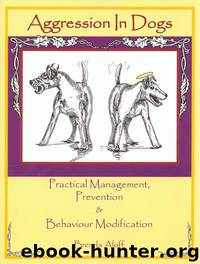Aggression In Dogs by Brenda Aloff

Author:Brenda Aloff
Language: eng
Format: epub
Publisher: Dogwise
Published: 2012-01-30T00:00:00+00:00
JEEZ, T HAT WAS A L OT OF WORK – N OW WHAT?
From these three pieces, the Daily Environment, the Hit List, and the Setting Events, a pattern will begin to emerge. You are able to see, perhaps for the first time, some of the connections between the three. From this systematic analysis, you are now able to think about the incidents more clinically, and more clearly.
These worksheets allow you to evaluate the contexts in which the aggression occurs. This allows you to avoid or to be ready for these instances, and also to “set-up” the environment carefully so you can show the dog how you want her to behave (manufacture reinforceable behaviour). It gives you the opportunity to reinforce desirable behaviour.
You will also derive from the worksheets:
• A list of precursors or triggers for the behaviour. This is crucial. Note or number the triggers from most to least likely to cause arousal in your dog.
• Determine a threshold for tolerance (distance). This allows you to begin your work with this in mind and improve safety and chances of success.
• A list of body language observed.
The Setting Events sheet will tell you which is the earliest observable behaviour you recognize that indicates the dog is even becoming marginally reactive? (It is at this Earliest Observable Behaviour that you should intervene or interrupt behaviour.)
From your lists, you may also be closer to determining Classification of the dog’s behaviour, if that is not already apparent to you.
The information provided from these lists will also help to choose which protocols to complete.
Information provided by the lists will identify the consequences that are providing reinforcement for the behaviour. This is VERY valuable information, since this tells us a lot about the function the behaviour is serving for the animal.
As indicated by the lists, you should now have quite a bit of organized information to go on. You will use these lists to create practice sessions.
ALWAYS complete the Foundation and Level I protocols first. Those are the exercises that all of the rest of the work is based on. A communication system, impulse control, and attentiveness to the handler are requisite for results. Most importantly, those protocols help to forge a working relationship between you and your dog built on trust, whether preventing or “fixing.” As you complete those protocols you will learn a lot about your dog that will aid you when you are making judgments about future protocols. As you practice the Foundation and Level I protocols, you will gain handler skill and build a Working Relationship with your dog. That will sure come in handy when you are raising criteria and placing yourself and your dog in more exciting, distracting, or arousing situations! Your dog will gain skills during those protocols that will assist in the more difficult work that you will be asking of her later.
Next, begin work on the protocols that address specific triggers your dog responds to.
Download
This site does not store any files on its server. We only index and link to content provided by other sites. Please contact the content providers to delete copyright contents if any and email us, we'll remove relevant links or contents immediately.
| Breeds | Care & Health |
| Training |
Finding Gobi by Dion Leonard(2781)
Grumpy Cat by Grumpy Cat(2687)
A New Earth: Awakening to Your Life's Purpose by Eckhart Tolle(2597)
The Silkworm by Robert Galbraith(2443)
Tippi by Tippi Hedren(2184)
End of Days by Sylvia Browne(2118)
Total Cat Mojo by Jackson Galaxy(1968)
Backyard Chickens Beyond the Basics by Pam Freeman(1905)
The Animals Among Us by John Bradshaw(1831)
The Ultimate Pet Health Guide by Gary Richter(1728)
All Things Bright and Beautiful by James Herriot(1709)
Vet in Harness by James Herriot(1665)
Doggy Desserts: 125 Homemade Treats for Happy, Healthy Dogs by Cheryl Gianfrancesco(1655)
Dog Years by Mark Doty(1643)
Cesar's Way by Cesar Millan(1636)
Chicken Soup for the Ocean Lover's Soul by Jack Canfield(1602)
Dog Training 101 by Kyra Sundance(1560)
Walking with Peety by Eric O'Grey(1555)
Animal Speak by Ted Andrews(1514)
